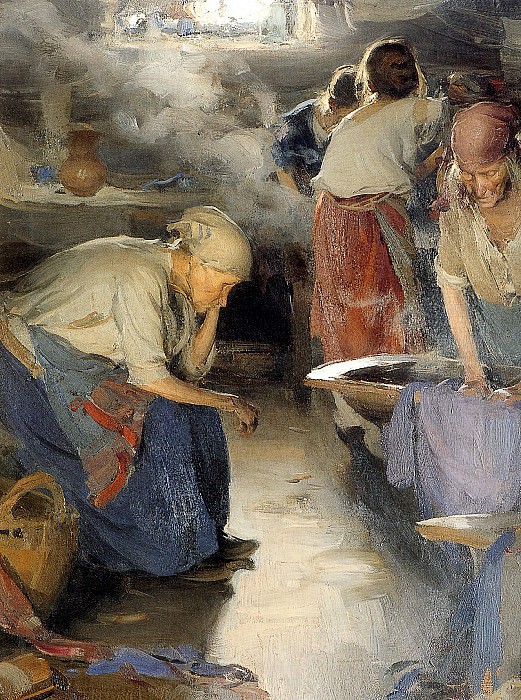Washers women Abram Arkhipov (1862-1930)
Abram Arkhipov – Washers women
Edit attribution
Download full size: 1276×1717 px (0,6 Mb)
Painter: Abram Arkhipov
Location: The State Tretyakov Gallery, Moscow (Государственная Третьяковская галерея).
His creative journey in the field of genre painting by A. Е. Arkhipov pursued his creative path in genre painting by painting a variety of episodes from the lives of peasants. The picture "Laundresses," revealing the subject of hard and exhausting work, Arkhipov started in the late 1890s, and finished in 1901. The work "Laundresses" is one of the most famous and at the same time one of the most important in the work of the artist. The painting was conceived in Moscow and inspired by a visit to the laundries located near the Smolensk market.
Description of Abram Arkhipov’s painting The Laundresses
His creative journey in the field of genre painting by A. Е. Arkhipov pursued his creative path in genre painting by painting a variety of episodes from the lives of peasants. The picture "Laundresses," revealing the subject of hard and exhausting work, Arkhipov started in the late 1890s, and finished in 1901. The work "Laundresses" is one of the most famous and at the same time one of the most important in the work of the artist.
The painting was conceived in Moscow and inspired by a visit to the laundries located near the Smolensk market. However, another location was chosen for posing, a corner in Arkhipov’s studio where the lighting corresponded to the basement of the laundry.
The first version of the canvas covers a greater number of figures, while the second is more laconic. In the first version, a group of laundresses forms a compositional circle and looks like a single whole. The mastery of the artist conveys their weariness, caused by exorbitant labor, and the effect of movement is achieved through the use of reflexes of light, playing on the wet surfaces of objects and pale faces of women. In the second version of the painting, the theme of hard work is revealed through the image of an old laundress sitting at the laundry trough and hunched over from fatigue.
The coloring of the painting is based on shades of gray, purple and lilac. Broad strokes convey the glitter of wet floor, the air soaked with moisture, the steam swirling around the washerwomen, and the pale light from the tiny window, the edge of which can be seen in the picture.
In the painting "Laundresses", first of all, a social motif can be traced: the utmost fatigue from hard work and awareness of the hopelessness of their situation, which also causes the women a sense of mental anguish, a sense of hopelessness and apathy. In addition to the social subtext, the painting implements a new artistic manner: generalization of form, almost complete abandonment of detail in the image, work with broad strokes and a desire for free writing.
Кому понравилось
Пожалуйста, подождите
На эту операцию может потребоваться несколько секунд.
Информация появится в новом окне,
если открытие новых окон не запрещено в настройках вашего браузера.
You need to login
Для работы с коллекциями – пожалуйста, войдите в аккаунт (open in new window).

















You cannot comment Why?